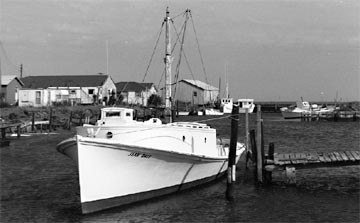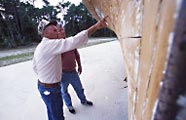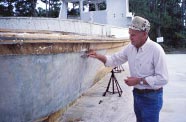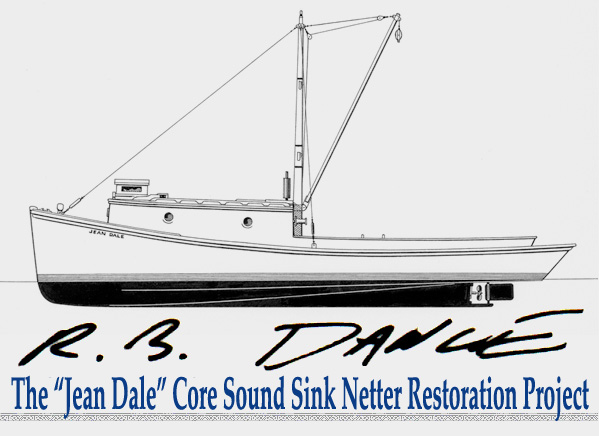 |
| Despite
her graceful lines, the Jean Dale was constructed
strictly as a working boat in the 1940s. Handcrafted
of longleaf pine and juniper planks, the sink netter
was built to handle the rigors of year-round commercial
fishing as evidenced by these photos of the boat in
the late 1960s on Harker's Island. |
The
Jean Dale
What
do you know about the Jean Dale?" I yell above the
sounds of circular saws and hammer beats. The September
sun is retreating westward toward Beaufort, and the salt-laden
air of Core Sound is thick all around. Clarence Willis drives
one last nail into a juniper plank and motions for his helpers
to knock off for the evening. Tanned island men silently
pack up their tools amid the sawdust and lumber and disappear
in the fleeting light, leaving me alone with Willis and
his son, Junior.
"What you want to know about her?" Willis asks
back sheepishly, arms folded, with an old hammer in the
crook of one arm and his strong back leaning squarely against
the bow of the unfinished wooden skiff. He looks me over
with the distrust of a stranger bearing beads for a one-sided
trade. I understand his distrust. Here on Harkers Island,
I'm considered a "dingbatter," an outsider. And
it's folks like me-in Willis' and most other natives' views-who've
changed this island, its people and their way of life.
"She is a Core Sound sink netter, right? One of the
last of her kind left?" I know enough to ask the right
questions.
 "She was just another fishing boat-the Jean Dale. There
was a time when there were 50 or 60 boats like her on this
island," Willis responds matter-of-factly. "But
there ain't many left anymore." His 71-year-old blue
eyes flash back to the past, and I know he knows more. His
leathered arms unfold and relax as he continues. "She was just another fishing boat-the Jean Dale. There
was a time when there were 50 or 60 boats like her on this
island," Willis responds matter-of-factly. "But
there ain't many left anymore." His 71-year-old blue
eyes flash back to the past, and I know he knows more. His
leathered arms unfold and relax as he continues.
"She
was a good sea boat built for Harry Lewis back in the early
'40s" Willis explains as he lays down the hammer on
a sawhorse. "She was a real fishing boat, maybe 40
foot long. Harry worked her year-round-shrimping and pulling
nets," he said. "Sank twice and caught afire once,
but they didn't give up on her."
And
the Jean Dale didn't give up either. The planked boat, built
of heart pine and juniper, was fished nearly continuously
for 50 years, Willis explained, bringing back loads of shrimp,
gray trout, spot and sea mullet to Harkers Island. Once,
Harry sank her off Brown's Island in rough seas with a heavy
load of jumbo croakers -maybe 120 to 125 boxes full. "It
brigged up on him; and with so much weight, the stem went
down. But they raised her and got her dry in a day or two
and went back at it again."
Harry
Lewis was the sole owner of the Jean Dale. And when he got
too old to fish her, his grandson took up fishing the boat
for a while. "She didn't owe Harry nothing," Willis
said. "She had well paid for herself."
"Who
built the Jean Dale?" I blurt out, guessing that Willis
knows much more.
"Brady
Lewis built her, along with some other men on the island.
And I helped work on the Jean Dale when I was young,"
he explains. "Brady Lewis-well, he's the one that started
this (boat-building) mess with the flared bow-'flow'r' we
call it, and he taught me too. I quit school when I was
13 and started working for Brady. At first, he would just
let me hold the planks. But he got to where he would trust
me more to cut the planks."
Famed
boat-builder Brady Lewis crafted the Jean Dale, with the
help of others including Clarence Willis (above) who was
a teen-ager at the time. Now in his 70s, Willis is working
with others on Harker's Island to restore the historic fishing
boat.
 |
 |
| Famed
boat-builder Brady Lewis crafted the Jean Dale,
with the help of others including Clarence Willis (above)
who was a teen-ager at the time. Now in his 70s, Willis
is working with others on Harker's Island to restore
the historic fishing boat. |
The
Jean Dale was indicative of the "Harkers Island boat,"
Willis explained. She was narrow, long and graceful with
a distinctive flared bow-made famous by Brady Lewis-and
a low transom and a rounded stern to prevent the fishing
nets from hanging up when they were pulled in by hand by
a three-man crew. She had a fairly flat bottom for a shallow
draft to navigate the waters of Core Sound. But the flared
bow, with just enough dead rise, helped cut the waves offshore
in heavy seas. "The narrower the boat, the more dead
rise," Willis said. "A narrow boat was a better
sea boat. But you didn't let her get side-to in rough seas.
You took your waves head-on. And the round stern worked
good for pulling in the sink nets," he added.
The
Jean Dale was fitted with a six-cylinder Chrysler gasoline
automobile engine and had a 22-inch wheel (propeller), Willis
explained. But she could make 18 to 20 knots in good conditions
at 3,400 rpm's. And she had a distinctive "doghouse"
up front where the captain could pilot her in rough conditions.
Brady
Lewis-considered by many the father of North Carolina boat
building-is credited on Harkers Island with developing the
flared-bow boat. He devised a simple mathematical formula
to lay up the narrow juniper planks in various widths in
nearly seamless perfection to create the distinctive bow
shape. "He just got it in his head, the flow'r,"
Willis said. "Besides, it makes a prettier boat anyhow."
Before the days of modern fiberglass, Brady Lewis taught
Willis and many others on the island how to work out the
calculations for the graceful curves of wood. In his nearly
60 years as a boat-builder, Willis has built hundreds of
wooden boats, from skiffs all the way up to 70-footers.
But he's never touched fiberglass and never will. "Can't
stand the stuff. In my opinion, it makes a sorry boat-too
easy to bust her with fiberglass. Wood is much stronger.
I wouldn't even try to guess at the number of wood boats
I've built. I've retired twice from it, but then somebody
on the island wants me to build 'em a boat."
That's
where this 24-footer he's working on came from. The plans
themselves are not written down-each one comes from Willis'
head, just like his teacher, Brady Lewis, did it. But too
few builders work with wood anymore.
Willis
wistfully thinks back. "I wish it was back like it
was 20 years ago. There's too few working in the fishing
now, and wood and materials are too expensive. There's still
some juniper left, but no heart pine. And everybody wants
fiberglass now. Used to be people made boats for people
who used boats to work and earn a livin'. Then the big people-the
moneymen-got into it with fiberglass. Naturally, the dingbatters
came in too. They put the damper on us and wooden boat-building."
History
of the Core Sounder
Built
as a commercial workboat, the clean lines of the Jean Dale,
with its flared bow and rounded stern, represent a pinnacle
in North Carolina boat building, explains Mike Alford, former
curator of maritime history at the North Carolina Maritime
Museum. And the lasting popularity of the flared bow made
famous by the wooden boat-builders on Harkers Island and
Core Sound has spread up and down the East Coast and is
still found in an exaggerated form in the modern fiberglass
fishing boats of today.
The
Core Sounders, as this class of boat was called, once dotted
the small harbors of Harkers Island and nearby coastal communities.
Sleek and gleaming white, they had a low, graceful sheer
that swept up to a smart, flared bow, while the aft end
terminated in a low, almost dainty round stern, Alford explained.
There was a simple low cabin forward that sheltered a galley,
a couple of berths for the crew and a bad-weather steering
station. Directly over the station a hatchlike windowed
box allowed the helmsman to poke his head up and look around.
Built on the island, and in a few nearby mainland communities,
they ranged in length from around 35 feet to more than 40
and were powered by single engines.
"In
the building of boats, there is a general maxim that changes
occur slowly and only when necessary," Alford said.
"Probably nothing ever overhauled the boat builder's
status quo more significantly, or as rapidly, as did the
advent of the internal combustion engine."
 The
story of the Core Sounder began when the fishing community
began to accept gasoline engine power as a viable alternative
to sail. In North Carolina that was near the end of the
first decade in the 20th century. Three decades later, the
Core Sounder emerged. Although elements of its design and
construction can be traced back to sailing craft, the Core
Sounder represents what might be considered the perfection
of a power-driven hull, explains Alford, not as the end
result of a series of modifications to sailing hulls. The
story of the Core Sounder began when the fishing community
began to accept gasoline engine power as a viable alternative
to sail. In North Carolina that was near the end of the
first decade in the 20th century. Three decades later, the
Core Sounder emerged. Although elements of its design and
construction can be traced back to sailing craft, the Core
Sounder represents what might be considered the perfection
of a power-driven hull, explains Alford, not as the end
result of a series of modifications to sailing hulls.
Boat-building
has always been a major interest in North Carolina since
its earliest days as a colony. Prior to the Civil War, boats
built with logs were the rule. Following the war, two boat
types dominated inshore fish-ery and commercial activities
in the state. The round-bottom shad boat, with its versatile
sprit-main and jib rig, prevailed in the northern sounds-the
Albemarle, Pamlico and Croatan. Core Sound, to the south,
was the stronghold of the sharpie-a flat-bottomed immigrant
from Connecticut. By the late 1800s, sharpies were found
as far south as Wilmington and Southport, and as far north
as the sounds extended. But Core Sound was their stronghold.
By
the early 1930s, with powered boats everywhere, the new
challenge was a demand for "bigger and better"
boats that could navigate the shoal sounds, contend with
summer squalls and venture into deep-sea fishing grounds.
Enter the Core Sounders.
Brady
Lewis and those who learned from him began producing the
first of the Core Sounders in the 1930s. Earlier versions
were typically built on a 4-to-1 ratio of length-to-beam,
and were powered by engines of 115 horsepower or less. Just
before World War II and immediately after, boats experienced
a trend that saw horsepower double in a short time, and
length-to-beam ratios began a downward trend toward 3-to-1.
The
Jean Dale represents the best of the postwar boats, Alford
said. She is simple and clean, and has all the features
in the appropriate proportions that give the Core Sounders
their distinctive look: low freeboard, saucy bow flare and
a graceful round stern. By the early '50s, the use of larger
and faster engines resulted in less graceful proportions.
Deeper and more robust, the round stern was no longer the
sweetly balanced end of a sleek, easily driven hull. At
the same time the flared bow sections grew more and more
extreme. But the Jean Dale had the grace and charm that
well-balanced elements of design give to a boat. |







